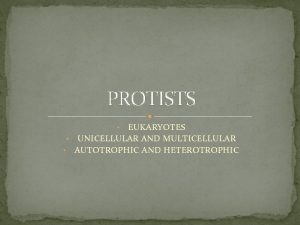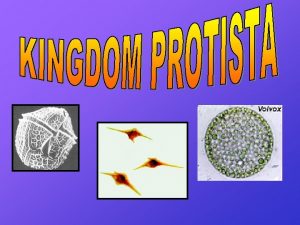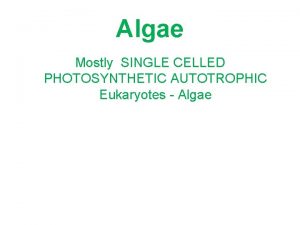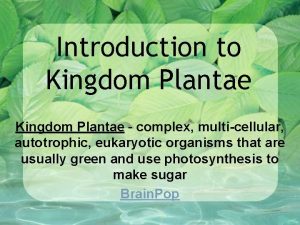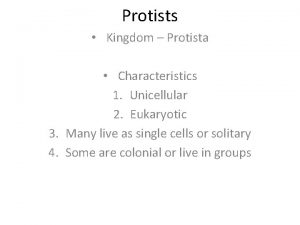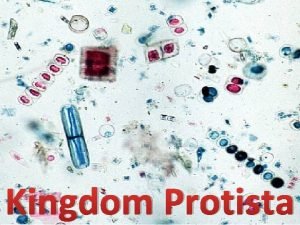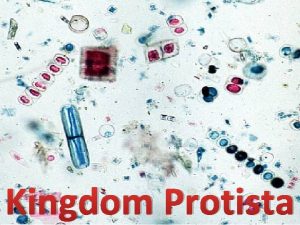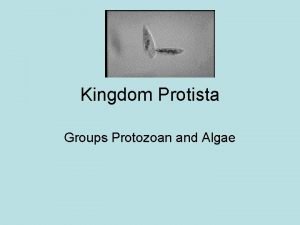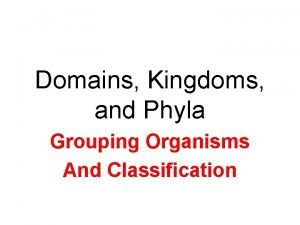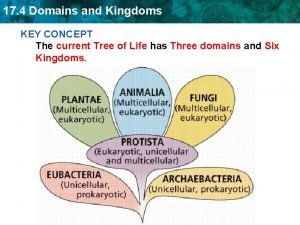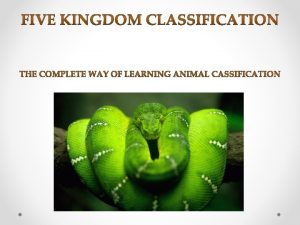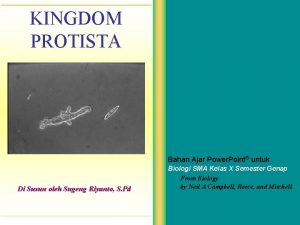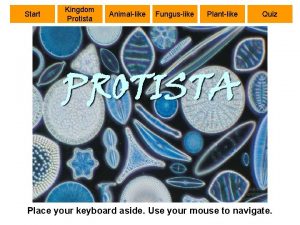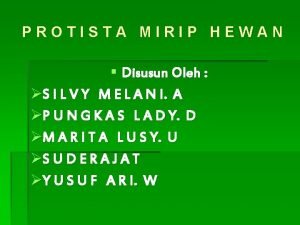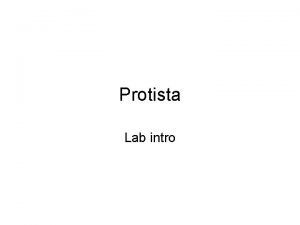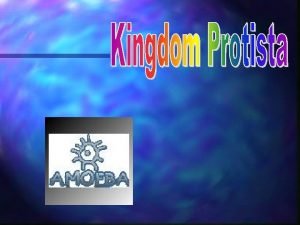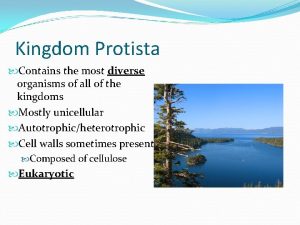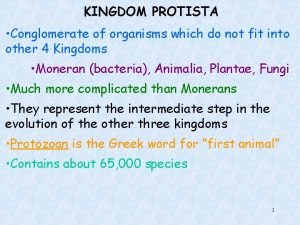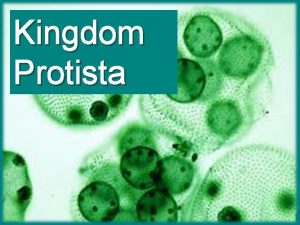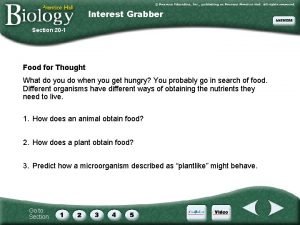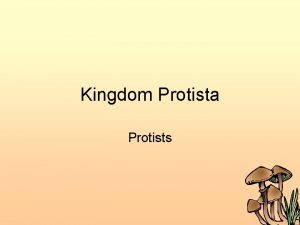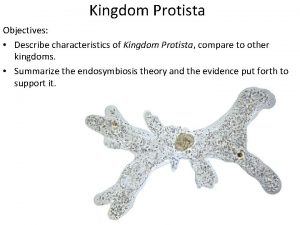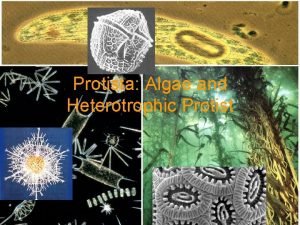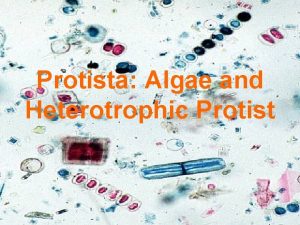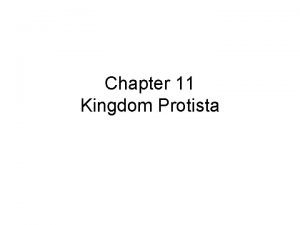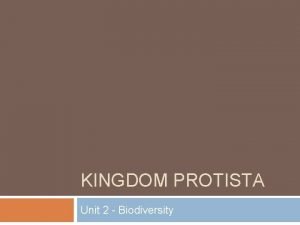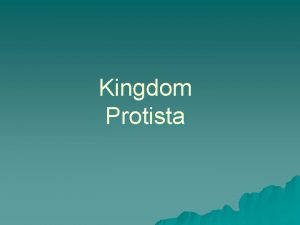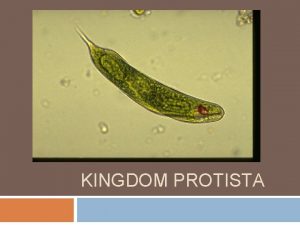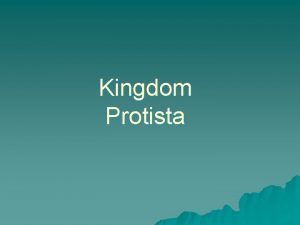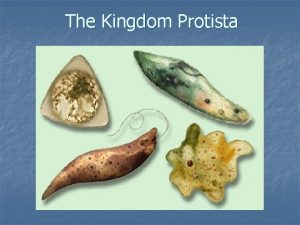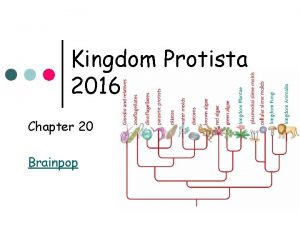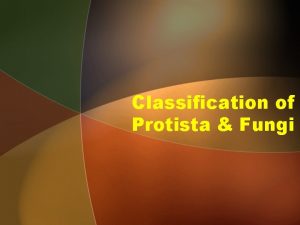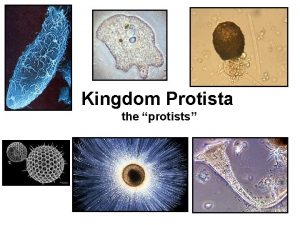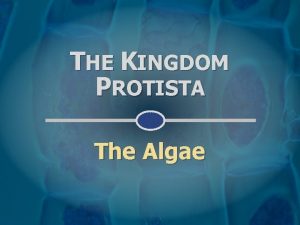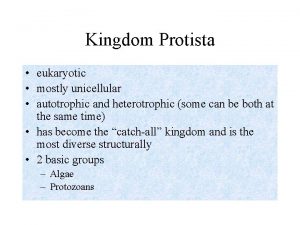Kingdom Protista 1 Algae Characteristics of Algae Autotrophic
































- Slides: 32

Kingdom Protista 1. Algae

Characteristics of Algae • Autotrophic • Not plants: reclassified. Why? • Often contain pyrenoids • Pyrenoids are biochemical compartments within the algal equivalent of chloroplasts • Function not completely understood. May play a role in carbon concentration • In other words, they don’t possess plant-like chloroplasts

Significance of Algae • Represent the transition from unicellular to multicellular • Are most likely the ancestors of plants • Are major contributors to early oxygenation of the environment • Begin the move away from completely aquatic environments

Structure of Algae • • • Thallus or body Unicellular or multicellular Colonial: Volvoz Filamentous: Spirogyra Multicellular: Ulva Asexual and sexual reproduction

General structure

Phylums • • Phylum Chlorophyta Phylum Phaeophyta Phylum Rhodophyta Phylum Bacillariophyta Phylum Dinoflagellata Phylum Chrysophyta Phyla Euglenohyta

Phylum Chlorophyta • Look familiar?

Continued… • • • Green algae Many different forms Gave rise to land plants – why? Analogues of choroplasts contain a and b cholorphyll Have carotenoids Cell walls of cellulose

Ulva

Colonial Chlorophyta

Phylum Phaeophyta • • • Brown algae Marine Seaweed and kelps Cooler areas of ocean Fucoxanthin pigment Store food as laminarin ALL multicellular Stemlike stipe Leaflike region called blade


Phylum Rhodophyta Red algae but colors vary Marine seaweeds Smaller than brown algae and live in deeper waters Phycobilins – pigment for absorbing light Some coated with polysaccharide carageenan – cosmetics, gel capsules, cheeses • Agar – extracted from cell walls of red algae • • •



Phylum Bacillariophyta • • • Diatoms (along with radiolaria) Shells fit together like a box with a lid Centric and pennate Main component of phytoplankton Diatomaceous earth


Phylum Dinoflagellata • • • Dinoflagellates Small, unicellular Most photosynthetic Some bioluminescent Red tide a problem



Phylum Chrysophyta • • • Golden algae Most fresh water Form cysts 2 flagella Carotenoids give color Important formation of petroleum deposits




Phylum Euglenophyta • • • Euglenoids Plant-like and animal-like characteristics Many have cholorphyll and are photosynthetic No cell wall, motile Most live in fresh water See picture on page 533

Euglena: A headache for biologists • Why? • Is it a plant? • Is it an animal? • A good example that shows that classification is not clearly compartmentalised. The lines between major groups of organisms are very blurred



Fungus-like protists • Slime molds: Phylum acrasiomycota ØCellular slime molds ØAmoeboid movement Phylum Myxomycota ØPlasmodial slime molds ØMass of plasmodium • Water molds Phylum Oomycota ØBlight Phylum Chytridiomycota ØChytrids ØZoospores with one flagellum ØMaybe fungi?

Slime molds

Water molds

Chytrids
 Multicellular heterotrophic
Multicellular heterotrophic Is a paramecium autotrophic or heterotrophic
Is a paramecium autotrophic or heterotrophic Algae are autotrophic. *
Algae are autotrophic. * Old kingdom middle kingdom new kingdom
Old kingdom middle kingdom new kingdom Old kingdom middle kingdom new kingdom
Old kingdom middle kingdom new kingdom Youtube
Youtube Old kingdom middle kingdom new kingdom
Old kingdom middle kingdom new kingdom Multicellular eukaryotic autotrophic organisms
Multicellular eukaryotic autotrophic organisms Protist characteristics
Protist characteristics Protista is unicellular or multicellular
Protista is unicellular or multicellular Nutrition in protists
Nutrition in protists Characteristics of protoctista
Characteristics of protoctista Kingdom protista characteristics
Kingdom protista characteristics Ciri ciri mastigophora
Ciri ciri mastigophora Protista kingdom
Protista kingdom King phillip came over from great spain
King phillip came over from great spain Chapter 17 domains and kingdoms concept mapping answers
Chapter 17 domains and kingdoms concept mapping answers Classification of protista
Classification of protista Animalia fungi plantae
Animalia fungi plantae Kingdom protista ppt
Kingdom protista ppt Plantae domain
Plantae domain Kingdom protista quiz
Kingdom protista quiz Introduction to the protists
Introduction to the protists Kingdom protista multicellular unicellular
Kingdom protista multicellular unicellular Protists habitats
Protists habitats Kingdom protista prokaryotic or eukaryotic
Kingdom protista prokaryotic or eukaryotic What is protophyta
What is protophyta Amoeba kingdom
Amoeba kingdom Sexual reproduction
Sexual reproduction Pseudopodia
Pseudopodia Archaebacteria characteristics chart
Archaebacteria characteristics chart Distinguishing features of kingdom protista
Distinguishing features of kingdom protista Section 20-1 the kingdom protista
Section 20-1 the kingdom protista
